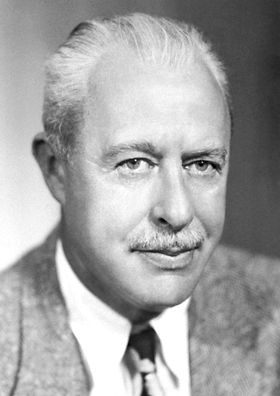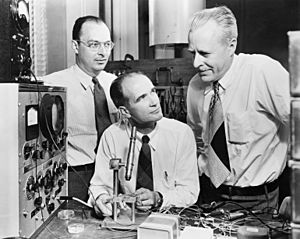Walter Houser Brattain facts for kids
Quick facts for kids
Walter Houser Brattain
|
|
|---|---|

Brattain c. 1950
|
|
| Born | February 10, 1902 Xiamen, Fujian, China
|
| Died | October 13, 1987 (aged 85) Seattle, Washington, U.S.
|
| Nationality | American |
| Alma mater |
|
| Known for | Transistor |
| Relatives | Robert Brattain (brother) |
| Awards |
|
| Scientific career | |
| Fields | Physics, electronic engineering |
| Institutions |
|
| Doctoral advisor | John Torrence Tate Sr. |
Walter Houser Brattain (born February 10, 1902 – died October 13, 1987) was an American physicist. He worked at Bell Labs. Along with fellow scientists John Bardeen and William Shockley, he helped invent the point-contact transistor in December 1947. This invention changed electronics forever. The three scientists shared the 1956 Nobel Prize in Physics for their amazing work. Brattain spent much of his career studying how surfaces of materials behave.
Contents
Walter Brattain's Life Story
Walter Brattain was born in a city called Amoy, which is now Xiamen, in Fujian, China. His parents, Ross and Ottilie Brattain, were Americans. His father was a teacher, and his mother was very good at math. Both of his parents had gone to Whitman College.
In 1903, when Walter was a baby, his mother brought him back to the United States. His father followed soon after. The family lived in Spokane, Washington, for a few years. Then, in 1911, they moved to a cattle ranch near Tonasket, Washington.
School and College Years
Walter went to high school in Washington state. He spent time at different schools, including Queen Anne High School and Tonasket High School. He also attended the Moran School for Boys.
After high school, Brattain went to Whitman College in Walla Walla, Washington. There, he studied physics and mathematics. He earned his first degree from Whitman in 1924. Walter and three of his classmates, Walker Bleakney, Vladimir Rojansky, and E. John Workman, all became famous physicists. They were even known as "the four horsemen of physics." Walter's brother, Robert Brattain, also became a physicist and followed him to Whitman College.
Walter continued his education, earning a Master of Arts degree from the University of Oregon in 1926. He then got his Ph.D. from the University of Minnesota in 1929. At Minnesota, he learned about quantum mechanics, which was a new and exciting field of physics.
Family Life
Walter Brattain was married two times. His first wife was Keren Gilmore, a chemist. They got married in 1935 and had a son named William in 1943. Keren passed away in 1957. The next year, Walter married Emma Jane Miller, who had three children of her own.
In the 1970s, Walter moved to Seattle. He lived there until he passed away on October 13, 1987, from Alzheimer's disease. He is buried in Pomeroy, Washington.
Walter Brattain's Scientific Discoveries
From 1927 to 1928, Walter Brattain worked at the National Bureau of Standards. There, he helped create standards for measuring electrical frequencies. In 1929, he joined Bell Telephone Laboratories as a research physicist.
At Bell Labs, Brattain studied how electricity moves through materials like copper oxide. He also discovered something important: how light affects the surface of a semiconductor. This work was a big step in understanding how solid materials conduct electricity. The Nobel Prize committee recognized this as one of his most important contributions.
The Need for a New Technology
Back then, the telephone industry relied on vacuum tubes to control electricity and make signals stronger. But vacuum tubes were big, used a lot of power, and often broke. Bell Laboratories wanted to find a better way.
In the 1930s, Brattain worked with William Shockley on an idea for a new kind of amplifier using semiconductors. It didn't work at first, but it was an early step toward the field effect transistor. Other scientists were also trying to use materials like germanium and silicon for electronics.
During World War II, Brattain and Shockley both worked on projects to detect submarines. Brattain's team developed special magnetometers that could find submarines by sensing changes in the earth's magnetic field.
The Transistor is Born
In 1945, Bell Labs created a new team to study solid-state physics. This team included Shockley, Stanley O. Morgan, and John Bardeen. Bardeen was a quantum physicist, Brattain was a skilled experimenter, and Shockley led the team. They often played bridge and golf together.
Shockley had an idea for a transistor, but it wasn't working. He asked Brattain and Bardeen to figure out why. For weeks, they did many experiments. Bardeen thought that tiny problems on the surface of the material were stopping the electricity.
Finally, Brattain and Bardeen found a way to make a small amount of amplification. They used a gold metal point pressed into silicon, surrounded by water. When they tried germanium instead of silicon, the amplification got even better, but only for low-frequency signals.
On December 16, Brattain tried a new setup. He placed two gold contacts very close together on a germanium surface. He found that if he put a positive electrical charge on one contact, it made the signal stronger. This was a huge breakthrough!
On December 23, 1947, Walter Brattain, John Bardeen, and William Shockley showed their colleagues the first working transistor. This tiny device could make small electrical signals much stronger and process digital information. The transistor became "the key enabler of modern electronics."
In 1956, the three men received the Nobel Prize in Physics. They were honored "for research on semiconductors and the discovery of the transistor effect."
Sharing the Discovery
After the transistor was invented, Bell Labs kept it a secret at first. They wanted to make sure they had patents for the invention. But then, they decided to share their new knowledge with other companies and universities. This helped transistor technology grow very quickly. Bell Labs held special meetings where hundreds of scientists learned about the transistor.
Shockley felt he deserved most of the credit for the transistor. He started working on a new type of transistor, the junction transistor, and didn't include Bardeen and Brattain in that work.
Brattain moved to a different research group at Bell Labs. He kept studying the surfaces of materials to understand how semiconductors work even better. Bardeen left Bell Labs in 1951 and later won a second Nobel Prize for his work on superconductivity. Shockley also left Bell Labs in 1953 to start his own company.
When Brattain heard about the Nobel Prize, he said he was very grateful. He felt lucky to have been "in the right place, at the right time, and having the right sort of people to work with." Each of the three scientists gave a lecture about their work. Brattain spoke about the "Surface Properties of Semiconductors."
Later in his career, Brattain also studied how electricity works in living things. He became interested in blood clotting after his son needed heart surgery.
Teaching Career
Walter Brattain loved to teach. He was a visiting lecturer at Harvard University in 1952. He also taught at his old college, Whitman College, starting in 1962.
When he officially retired from Bell Laboratories in 1967, he continued teaching at Whitman. He became an adjunct professor in 1972 and retired from teaching in 1976. Even after retiring, he remained a consultant for Whitman College.
Today, Whitman College offers the Walter Brattain Scholarships. These scholarships are given to students who have done very well in their schoolwork.
Awards and Honors
Walter Brattain received many awards and honors for his important work.
- Awards
- Stuart Ballantine Medal from the Franklin Institute, 1952 (with John Bardeen)
- John Scott Medal, 1954 (with John Bardeen)
- Nobel Prize in Physics, 1956 (with John Bardeen and William B. Shockley)
- Inducted into the National Inventors Hall of Fame, 1974
- Memberships
- National Academy of Sciences
- Franklin Institute
- American Physical Society
- American Academy of Arts and Sciences
- American Association for the Advancement of Science
- Commission on semiconductors of the International Union of Pure and Applied Physics
- Naval Research Advisory Committee
- Honorary degrees
- Doctor of Science, Portland University, 1952
- Whitman College, 1955
- Union College, 1955 (with John Bardeen)
- University of Minnesota, 1957
- Other recognition
- USS Brattain, a starship in Star Trek: The Next Generation
See also
 In Spanish: Walter Houser Brattain para niños
In Spanish: Walter Houser Brattain para niños



